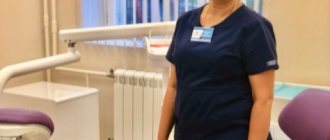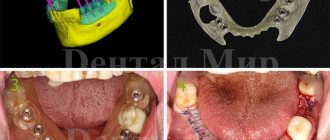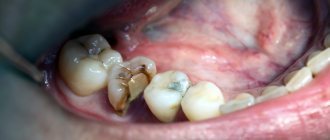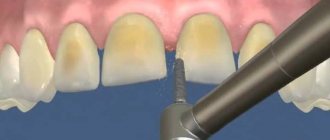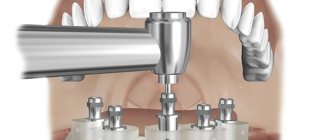Retrograde filling is a method of filling root canals with access through the root apex. It is indicated if it is impossible to carry out this procedure using the standard algorithm. Most often, it is used if it is impossible to remove previously installed filling material from the canal, although there are a number of other cases when this method is indicated. With the right approach, it prevents the penetration of pathogenic microorganisms through the root canals into periodontal tissue and alveolar bone and ensures effective closure of the apex area (root apex).
The CELT Dentistry Department invites you to undergo retrograde canal filling in Moscow. We have all the necessary licenses and certificates and work on the basis of an official contract with a guarantee. Our dentists have decades of experience in scientific and practical work, in which they are supported by a powerful diagnostic and treatment base, as well as effective and safe materials of the latest generation. You can find out the price of retrograde filling by going to the “Services and Prices” tab. We regularly update our price list, but to avoid misunderstandings, we recommend that you check the numbers with our information line operators or at a doctor’s appointment.
Dentist consultation - 1,000 rubles.
Retrograde canal filling (RTA) - 9,000 rubles.
Removing stitches - 350 rub.
At CELT you can get advice from a dental specialist.
- The cost of a consultation with a dental surgeon is 1,000
Make an appointment
Indications and contraindications for retrograde filling
Indications
- Impossibility of re-treatment of canals due to incorrectly previously filled canals using cement, pastes or their analogues, which does not allow unsealing;
- Anatomical features of the structure of the patient’s root canals, which are too long or have a strong curvature, which do not allow full endodontic treatment or make it impossible;
- Obliteration of root canals of various natures, including inflammation, malignant neoplasms, age-related changes and medical errors;
- The presence of fragments of endodontic files, anchor pins or stump inlays in the canal, which did not allow it to be hermetically sealed;
- The presence of a restoration on the tooth in the form of a fixed prosthesis, made of porcelain or metal ceramics, along with one or more of the above contraindications.
Contraindications
There are specific contraindications, which include mobility of teeth of the third or fourth degree due to periodontitis. At this stage of the disease, bone resorption exceeds 50% of the length of the tooth root, and the depth of the periodontal pockets is more than five millimeters.
In addition, there are a number of general contraindications that do not allow surgical dental interventions to be performed in the oral cavity. These include:
- Pregnancy in women;
- Periods of menstruation;
- Blood diseases that are characterized by disorders of blood clotting;
- Diabetes mellitus in the stage of decompensation;
- Infectious diseases in acute form;
- Chronic pathological conditions during periods of exacerbation;
- The patient has neoplasms of a malignant nature;
- Mental disorders.
Materials used
The retrograde filling procedure involves the use of various materials to restore the natural structure. The choice of a specific option depends on medical indications. Possible options include:
- Amalgam is one of the most common options, characterized by reduced shrinkage and ensuring the preservation of the natural anatomical shape of the tooth.
- Dental cements, the structure of which contains zinc oxide and eugenol, characterized by low thermal conductivity and a pronounced antiseptic effect.
- Restoration pastes used in the process of processing periapical tissues and providing hermetically sealed root canals.
- Super-EVA is a modified variety of zinc oxide eugenol pastes, offered by manufacturers in liquid and powder forms.
- Glass ionomer-based cement, the functional characteristics of which allow the formation of a high-strength filling in the shortest possible time.
Recommendations for the use of a particular material are determined by both the chosen treatment method and the financial capabilities of the patient.
Treatment and recovery
Before starting the retrograde filling procedure, the doctor prescribes a diagnostic set of measures, during which existing defects and pathological processes are localized. To relieve severe symptoms, analgesics, antibiotics, and anti-inflammatory drugs are used.
The surgical intervention itself involves the following procedure:
- Anesthesia of the surgical site.
- Excision of gum tissue and formation of a flap.
- Resection of the root apex to the canal cavity.
- Antiseptic treatment and removal of pathological formations.
- Placement of composite material in an open cavity.
- Restoration of tissue structure and aesthetic sutures.
Statistics show that the retrograde filling technique is successful in 95% of cases. The duration of the rehabilitation period is determined by the current state of the patient’s body. For a full recovery, it is important to strictly adhere to medical recommendations, as well as follow the rules and regulations of hygienic oral care.
The essence of retrograde root canal filling and the materials used
The essence of retrograde root filling is apicoectomy or resection of the root apex. This is a surgical operation that is aimed at removing the apical part of the tooth (including the pathological focus, if any). Having gained access to the canal, the dental surgeon processes and seals it.
Amalgam for retrograde tooth root filling
Despite a number of significant advantages, this material is used less and less often, since it can cause darkening of the gums, and the filling method is too labor-intensive. Today it is being replaced by modern materials that significantly simplify this procedure. At the same time, it is worth noting a number of advantages of amalgam:
- Ability to maintain a given shape well;
- Minimal shrinkage.
Zinc oxide eugenol cements for retrograde tooth root filling
COE are materials based on eugenol and zinc oxide. They are well compatible with dental tissues, as well as:
- Absolutely inert to them;
- They have antiseptic properties;
- Do not cause changes in hard dental tissues.
Their hardening time ranges from ten to twelve hours.
Glass ionomer cements for retrograde filling of tooth canals
GIC is the latest generation of materials with excellent strength and aesthetic properties. They are not susceptible to carious processes, allow you to select the desired shade, and provide radiographic contrast. Their other advantages:
- Functionality in wet environments;
- Excellent adhesion to different materials;
- Release of fluoride ions during the first year;
- Minimal shrinkage.
Indications for use
Factors that determine recommendations for retrograde filling include:
- The impossibility of re-treatment of a damaged element of the dentition, the cause of which turns out to be poor-quality filling performed earlier.
- Entry of foreign elements into the canal due to leaky obstruction.
- The development of natural processes leading to overgrowing of root canals, as well as a consequence of inflammatory processes or the formation of oncological tumors.
- Formation of apical deltas, excessive length, as well as curved shape of root canals, excluding the possibility of using traditional methods of endodontic treatment.
- Installation of fixed-category prostheses that limit access to the problem area requiring medical intervention.
Diagnosed pathological changes are considered as a basis for prescribing surgery. Symptoms that indicate the need for resection include severe swelling, the formation of canal fistulas, and acute pain.
At advanced stages of development, an opening of the periosteum area is also prescribed, followed by drug therapy. If the symptoms are not clearly expressed, but the patient complains of discomfort, a panoramic radiographic diagnosis is prescribed, including one that allows one to determine the abnormal position of previously installed dental fillings.
Reviews of doctors providing the service - Retrograde root canal filling
I would like to express my gratitude to the dentist Elena Nikolaevna Kiseleva and her assistant Svetlana - they are real specialists and at the same time sensitive, not burnt out by years of practice.
Thanks to them, I have been coming back here for many years. Thanks to the management for such doctors! Read full review Svetlana Nikolaevna
13.08.2021
I am very grateful to Evgeniy Borisovich Antiukhin for removing my three eights. Especially considering that the lower tooth was not the simplest (it was located in an embrace with a nerve). The removal took place in 2 stages, one tooth under local anesthesia, two under general anesthesia. I had no idea that wisdom teeth could be... Read full review
Sofia
28.12.2020
How is retrograde filling performed?
- An incision in the shape of an angle or trapezoid is made along the periodontal margin or 2 mm from it.
- After gaining access to the alveolar process, a hole is made in the cortical plate or the usura is expanded, if there is one.
- Cysts, granulomas and other changes in periapical tissues are removed.
- Resection of the upper part of the root is performed by 2 mm at an angle of 45°.
- A class 1 retrograde cavity is created in the root canal. Its depth varies from 1 to 2.5 mm.
- Hemostasis is performed.
- Filling is performed. Glass ionomer cement is usually used for this. It is resistant to tissue fluids during polymerization.
- The bone defect is filled with osteoplastic materials.
- Sutures are placed using atraumatic needles.
Preparation for retrograde tooth root filling
Before prescribing retrograde filling to a patient, CELT dentists conduct a full diagnostic study. It is indicated for microsurgical intervention and includes:
- Thorough dental examination;
- Sight radiography/panoramic photo;
- Test for individual intolerance to filling materials.
If there are no contraindications to filling, the dentist performs sanitation of the oral cavity, after which the patient is ready for intervention.
Cystectomy with root apex resection and retrograde filling
cysts (epithelial, non-epithelial) are cavities formed in tissues and filled with one or another liquid content.
Cysts are the most common benign tumor-like formations of the jaws, which usually have to be distinguished from each other, as well as from the cystic form of adamantinoma, fibrous dysplasia or eosinophilic granuloma of the jaw, etc.
In the example below, tooth-preserving surgery to remove a large cyst solved the problem even without removing the braces. In this case, resection of the root apices was not required.
| Before treatment. An extensive radicular cyst in the area of the roots of the lower incisors resulted from aggressive orthodontic treatment. | Treatment was carried out without resection of the roots of the teeth through conservative surgery and implantation of osteoplastic material. On an x-ray after 6 months, the inflammatory process was stopped. |
| In this case, there is a large cyst in the area of the roots of the teeth, which causes constant pain in the patient, especially when biting. Most clinics would suggest removing these teeth and then installing implants and new crowns in their place. | The operation of resection of the apexes of the roots of the teeth followed by retrograde filling made it possible to save the teeth on which core inlays and crowns were installed. Everything is saved, the problem is solved. |
| Unfilled canal of tooth 36. The focus of bone destruction is in the area of root bifurcation. Traditionally, such a tooth is recommended to be removed. | Clinical picture after 12 months. After resection of the apex of the problematic root followed by retrograde filling, the focus of bone tissue destruction was restored. The tooth is preserved. |
Principles of retrograde filling of the reserved root canal
It is carried out in several stages, which are as follows:
- Infiltration anesthesia - local anesthesia with the introduction of an anesthetic with a syringe into the soft tissue of the gums;
- Providing access to the apex of the root of a dental unit - an incision along the gum and peeling off its mucous membrane exposing the bone jaw tissue and excision of the apex of the root to the level of detection of the canals;
- Antiseptic treatment - the cavity remaining after excision is cleaned, removing fragments of pathological tissue from it (if any), filling it with tampons with an antiseptic;
- Preparation for retrograde filling - the apex is thoroughly dried and etched, after which the cavity is washed and also dried;
- Retrograde filling - the canal cavities are filled with filling materials, covered with tampons for five minutes to harden, after which antiseptic treatment is carried out and excess composition is removed;
- Suturing - the detached flap of gum is returned to its place and secured with sutures. During the first 48 hours after surgery, drainage will be required to drain the ichor.
Treatment and recovery
Before retrograde filling begins, a comprehensive diagnosis is carried out to identify abnormalities and pathologies. The presence of acute symptoms can be controlled with antibiotics and anti-inflammatory drugs. The surgical procedure algorithm is as follows:
- administering local anesthesia to the operated area;
- incision of the gum and separation from the jawbone;
- resection of the apical part of the root to the dental canal;
- anti-inflammatory treatment and cleaning;
- introducing a filling composition into the canal cavity;
- suturing the gums using surgical sutures.
The duration of wearing stitches is about a week. In some cases, three days of radiotherapy is used to reduce the consequences of surgery. Upon completion of treatment, an X-ray scan is performed to identify possible defects in the operation.
The success rate of the technique is 95%. The duration of the recovery period depends on the general condition of the patient's body. To increase the effectiveness of rehabilitation, it is recommended to follow medical instructions and follow hygienic procedures for oral care.
Recovery period after retrograde canal filling
The sutures are removed no earlier than after five days. During the recovery period, the patient must follow the doctor’s recommendations, which are as follows:
- During the first half hour, apply an ice compress to reduce swelling;
- Avoid consuming food or liquid for the first two hours;
- Avoid any physical activity for 24 hours;
- Carry out hygiene procedures regularly, but use a toothbrush with soft bristles;
- Systematically rinse the mouth with decoctions of chamomile and sage;
- Take antibiotics and stimulants according to the regimen prescribed by your doctor.
You can make an appointment with CELT dental surgeons online on our website or by contacting our information line operators.
Make an appointment through the application or by calling +7 +7 We work every day:
- Monday—Friday: 8.00—20.00
- Saturday: 8.00–18.00
- Sunday is a day off
The nearest metro and MCC stations to the clinic:
- Highway of Enthusiasts or Perovo
- Partisan
- Enthusiast Highway
Driving directions
Diagnosis and preparation for surgery
Retrograde filling requires diagnosing the indications for such a microsurgical operation. After the examination, an x-ray of individual teeth or a panoramic photograph is required.
If the patient has anomalies in the development of the root canals (greater curvature, length), then the optimal solution would be the retrograde filling technique.
Previously poorly performed treatment, filling, and prosthetics also require the use of the technique after it has been established that it is impossible to correct the situation using the traditional endodontic method.
In the presence of inflammatory processes (fistula, etc.), it is necessary to take priority measures to relieve acute symptoms (use of antibiotics).
If required, it is necessary to undergo tests to determine the tolerance of the components and materials of retrograde filling.
The oral cavity must be sanitized to the maximum extent possible and, if possible, rid of pathogenic microflora before surgery.

